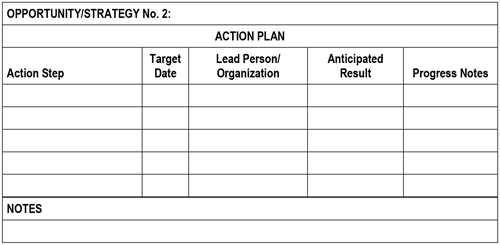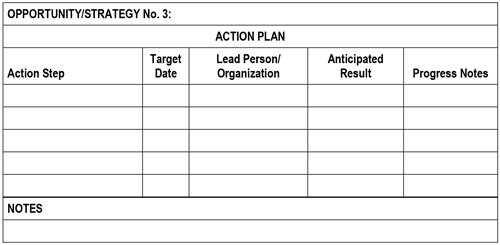U.S. Department of Transportation
Federal Highway Administration
1200 New Jersey Avenue, SE
Washington, DC 20590
202-366-4000
| < Previous | Table of Contents |
This tool is designed to help you move from a broad safety goal to effective and strategic action planning. This template will aid in the development of an effective implementation plan in which specific, measurable objectives, strategies, and action steps are identified to assist regional planners begin or better integrate safety in the planning process.
The strengths, weaknesses and opportunities identified in each planning area worksheet identified a preliminary list of strategies your organization can implement to enhance the integration of safety in the RPO transportation planning process. Moving forward, consider forming a small, focused team to select priority safety planning tasks, refine strategies for addressing the tasks, and completing the process by identifying specific action steps for accomplishing the strategies. The below Implementation Plan will assist with action step development.
An Implementation Plan template is provided to help you create goals, objectives, and action steps for each planning task. The Public Involvement planning task is intended to provide an example and guidance for using the tool. The following table provides definitions of key terms used in the Implementation Plan.
Table C.1 Implementation Worksheet
| Term | Description/Definition |
|---|---|
| Priority Planning Task | Enter the priority planning task to be addressed (e.g., Public Involvement, Multidisciplinary Coordination, Goals and Objectives, Performance Measures, Data Collection and Analysis, Project Prioritization and Programming, or Monitoring and Evaluation). |
| Goal | Create a statement outlining the desired end state, i.e., what you hope to accomplish related to this priority area. |
| Opportunity (Strategies) | List one opportunity (i.e., strategy) identified from the planning task worksheet. |
| Background | Provide a brief description of the specific strategies you plan to achieve. |
| Action Steps | Outline the steps you will take to achieve each strategy. Place each action step in a separate row, arranged chronologically. |
| Timeline | Establish a time period for each action step to be accomplished (number of months, years, etc.). |
| Lead Person/Organization | Identify the person or organization responsible for initiating/implementing the activity, providing direction for the work, and monitoring progress. The leaders are not expected to accomplish all the work; however, they will ensure the activities are carried out. |
| Anticipated Result | Describe the specific, expected results of the activity. This statement should operationalize the goal. |
| Monitoring and Evaluation | Track and regularly report progress on each activity. Evaluate the effectiveness of the strategies and activities and recommend course corrections where appropriate. |
Figure C.1 Example Completed Implementation Worksheet
Source: Sample worksheet created for purposes of this report.
Figure C.2 Sample Blank Action Plan Worksheet for Opportunity/Strategy #2

Source: Sample worksheet created for purposes of this report.
Figure C.3 Sample Blank Action Plan Worksheet for Opportunity/Strategy #3

Source: Sample worksheet created for purposes of this report.
| < Previous | Table of Contents |
